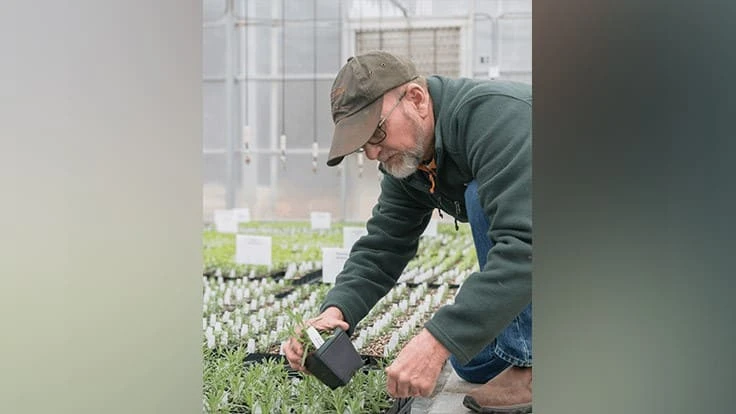

When Briscoe White made the decision to start selling plants online, he didn’t even own a computer. Back in 2005, White was a nurseryman and a family farmer, running the brick-and-mortar garden center he had co-founded with his wife Kenan in 1985. But he had bigger ideas for the future.
For the first 20 years of operation in, Richmond, Virginia, the garden center thrived. White grew much of the store’s plants at his nursery with greenhouses on a family farm in neighboring Charles City. “But then Lowe’s and Home Depot came along, and we had to get the hell out of Dodge,” White says.
It was then, at age 50, that White decided to take The Growers Exchange online. Over the next 15 years, the operation morphed into an exclusively online herb-exclusive, direct-to-consumer retailer, making more than $1 million in annual sales.
Building on its success and developing its web presence through strategic SEO and web marketing, the grower moved to a high-tech facility in an industrial park in Sandston, Virginia, in 2017, where they’re now neighbors with a Facebook data center and a technology park.
“You kind of identify yourself as being an internet-first company that happens to have a greenhouse,” White says.
By focusing on a niche market, automation and a strong online presence, the company is growing an average of 10% every year and in 2020, the company is up 70% year to date.
Going online
The idea to go online came to White while he was being interviewed by the business editor of the Richmond Times-Dispatch. When the reporter put White on the spot and asked, “What are you going to do next?” he responded, “We’re going to be on the internet.”
The company got to work, and after developing its first website, The Growers Exchange decided to test another version. That’s when Kenan started to take over and handle the tech side of the operation’s retail offerings.
“Back then, there weren’t that many website options,” White says. “This was maybe the second generation of web commerce.”
Kenan, who was running the garden center and attending graduate school for a degree in social work, decided to come back to the company to get yet another website up and running.
The third time was a charm. “That one actually did e-commerce correctly. We had good shopping carts and all of that,” White says.
SEO and marketing
In 2007, The Growers Exchange hired an SEO firm and sold its original property with the greenhouses. Then, the Great Recession hit. But that didn’t stop White from moving forward with building his company.
He kept on with hiring and expanding, adding key team member Jessica Smith to the staff. Smith is now The Growers Exchange’s No. 2 in command when it comes to company operations. “I always used to tell her that when I was in business school we would do case studies on Procter & Gamble and General Mills and companies like that,” White says. “They’re here because they put the petal to the metal during the Great Depression. It can work out.”
In the midst of an advertising freeze for many companies, The Growers Exchange kept on getting the word out and their marketing efforts were extremely effective. “I mean nobody was advertising,” White says, so the company was able to expand its customer base quickly. Now, they have more than 100,000 customers.
Starting off slowly, the business picked up so many new customers that it finally outgrew its growing operation. The website was doing so well, in fact, that The Growers Exchange reached its shipping limits.
“We were running really short, so I built this place gambling — you know, now I’ve got a mortgage on my head. And we’ve been growing like crazy since we made this place,” White says.
_fmt.png)
Shipping, sales and service
Because of the volume of shipping, White describes The Growers Exchange as a “plant factory.” To manage the sheer number of plants going out, White has precise growing programs and inventory control systems to keep things moving smoothly. The company even uses warehousing software to help manage the flow of plants.
“We’re exactly like a warehouse,” White says. “Warehousing software matches greenhouse shipping stuff pretty closely.”
Shipping, in fact, is the company’s No. 1 expense. Each week the team reviews the shipping report to make sure they aren’t losing money on shipping. “My UPS bills are staggering,” White says.
But growing plants that you can ship is different than growing plants that someone will be able to put in the back of their car. White says the process took The Growers Exchange several years to figure out, but now, the company grows more than 175 varieties of herbs.
“That’s our niche,” White says. “We feel like we have an established brand for that online because we come up on the first page when you Google search for herb plants.”
Part of their niche is also the unique and hard-to-find varieties the company offers. Because they’re able to focus on herbs exclusively, they don’t need to keep to the same growing cycle as other operations that also offer annuals and other ornamental crops.
If there’s an issue with sales or orders, customers don’t have to pick up the phone. The Growers Exchange has automated service and has streamlined it to the point that the company only receives three or four calls a week.
“In our off season, we get in our conference room and we go through our CRM and find out all of the questions that were asked and we answer them on our website,” White says. “We answer them on our blog and we provide the information so it’s there and they don’t need to call us. We worked very long and very hard on perfecting that.”
Labor-saving tech
The greenhouses at The Growers Exchange currently consist of five A-frame, polycarbonate rigid skin houses with Wadsworth Seed controls. With the old greenhouses built in the late '80s, temperature was controlled by individual thermostats — meaning White had to adjust them by hand. With the new controls, no one even has to come into the greenhouse on the weekends. From video feed of seedlings to irrigation updates, they can monitor the greenhouses remotely.
“This automation stuff has saved so much labor,” White says.
White says one of his favorite upgrades has been the automatic shade curtains that also act as heat curtains in the winter. “I don’t know how I existed before without it,” he says.
Another favorite feature of his is the roof plan with a passive ventilator. The greenhouses have vertical airflow fans now. By running those and opening the roof vents, they’re able to keep their humidity and temperatures at optimal levels without using much power. “Most of the time, we’re sitting here with modest weather and we don’t need to use electricity,” White says.
And to keep things simple, each plant in the 1801 flats the company uses will be sold in a 3.25-inch pot directly to the end consumer. While each plant is grown and treated as an individual sale, the company does offer discounts for large orders.

Inventory and guarantees
Back when The Growers Exchange started selling online, there was uncertainty and hesitancy surrounding ordering through a website. “Almost everybody felt like they were using a slot machine or playing Russian roulette when they put their credit card in during the beginning years,” White says. “We had to do anything we could to prove ourselves.”
While concerns over credit card safety are less of an issue today, ordering plants online is still a new experience for many consumers. To alleviate concerns about plant shipments, The Growers Exchange offers a guarantee policy for plants that fail within 14 days. White says they’ll often go above and beyond for customers as well, as long as they don’t seem like scammers.
“If you’ve got a problem, we are going to try to fix it.,” White says. “That’s our general attitude, anyway. We’re here to help them garden.”
Order optimization
The Growers Exchange starts its sales season with preorders and ships by USDA Zone, starting with 10 and 9 in the first week of March. “One advantage we have is that with a lot of the plants we grow, if you don’t get them while we have them, you might not find them this spring,” White says.
Monitoring online sales and matching it with inventory can be a tricky job, but The Growers Exchange has built a well-oiled machine. “Inventory is very important to us because the worst thing we can do is sell plants we don’t have,” White says.
Using in-depth data from its marketing agency and its Shopify platform, The Growers Exchange is able to determine what it needs by reviewing crop statuses each week. The team then makes notes in an app for website updates. “We don’t do anything like throwing darts anymore,” White says.
Growth now and in the future
Google Analytics and a good e-commerce marketing company are key components of The Growers Exchange’s marketing strategy. White and his team have gone through several marketing companies over the years as more options have become available.
“Nine-tenths of being on the internet is performing like a website and getting found in daily searches. It’s not involved in a lot of greenhouse stuff,” he says.
The company recently hired a new web marketing company and upgraded its shipping software, and over the summer, the team updated all of their back-end material in preparation to migrate to Shopify Plus, which they did this spring.
“They’re the shiny, new ones and it’s really improved our customer experience,” White says, noting that the platform is faster with better pictures and an easier checkout process.
And in an effort to boost spring sales even more, the company is extending its shipping season to the end of June — a decision they made while they were setting up their new site. While discussing day-to-day marketing, their ad company pointed out that June sees the highest demand for people looking for herb plants.
“I didn’t know that,” White says. “So we’re going to be open in June with a full inventory and see how that goes.”
The Growers Exchange has plans to keep growing too. While the customer base is made up mostly of women 45 and older, the company is going to start targeting their marketing to millennials. “They’ve only recently become good targets because now they’re all getting married and buying houses and having babies and acting domestically. So they’ve become our future market, so we’re trying to add them,” White says.
While The Growers Exchange is out of the entrepreneurial phase, White says, there’s still plenty of room to grow. With space for five more greenhouse, they’re planning to build over the next few years and continue expanding the herb operation for years to come.

Explore the June 2020 Issue
Check out more from this issue and find your next story to read.
Latest from Greenhouse Management
- Pennsylvania Horticultural Society announces 2025 Gold Medal Plant winners
- Oasis Grower Solutions announces new Southeast territory sales manager
- A nation of gardeners: A history of the British horticulture industry
- Last Word with Angela Labrum, Bailey Nurseries
- Iowa plant supplier Plantpeddler building retail complex
- This month's Greenhouse Management magazine is about native plants and sustainability
- The HC Companies, Classic Home & Garden merge as Growscape
- Terra Nova releases new echinacea variety, 'Fringe Festival'





